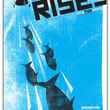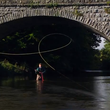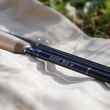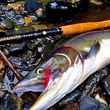While talking over the finer points of their newest reel with Orvis' Tom Rosenbauer, it was abundantly clear that Orvis was excited about the new Hydros SL, which the company labored over and tested for some time before settling on its final design.
The excitement, it seems, comes with good reason. Orvis has put together an impressive offering in its relatively new Hydros SL fly reel. Available in sizes that will take anglers from small freestone streams in search of trout to the deck of a skiff in hopes of tarpon, the Hydros SL is a fully machined bar stock aluminum fly reel with the features and craftsmanship that are commonly found in high-performance reels.
It wasn't an altogether uncommon conversation — as far as conversations go with high-performance reel makers, who predictably get giddy and a bit nerdy about their products — except for the reveal of the price tag.
Now, more than ever, fly fishers can lay their hands on reels with impressive features and craftsmanship for increasingly reasonable prices. And, thanks to a relatively paltry asking price when compared to reels of comparable quality, the Orvis Hydros SL may be the new figurehead of this continuing trend of impressive fly reel values.
What works
Startup Inertia
Reel makers love to talk about how powerful their reel's drag is, about what manner of animal or machine it can stop, and so on. And a powerful drag can be important. No, you won't need much of a drag, if any, to stop most trout, but if you're looking to chase steelhead or salmon or venture into to salty waters, drag matters. In my opinion, however, it isn't a powerful drag that separates true high performing reels from their competition, it is startup inertia.
If you're not familiar with startup inertia, it is simply how smoothly a reel's drag engages. When a fish tugs on the line, does the spool turn softly and ease into action as the drag takes hold, or does it grab tightly and snap into action? The latter is the opposite of what you want, as it leads to break offs and other manners of lost fish. And, unlike the power of a reel's drag, the startup of that drag is important both with trout and more powerful quarry. When you hook a feisty, 23 inch rainbow on 5x tippet, you won't need a powerful drag — but you will need one that grabs smoothly when that trout decides to make an angry run for it.
Silky smooth startup inertia is a hallmark of the best high-priced, high performance reels — but it is worth noting that getting spendy doesn't guarantee you'll get a reel with crisis-proof startup inertia. I've had far too many run ins with reels that cost well over $500 that fail to deliver on the startup inertia front. The Orvis Hydros SL, however, delivers here in spades, and does so at a value that is a fraction of the cost of competitors with similar performance.
The Spool
Orvis likes to tout the super-large arbor on the Hydros SL, which hauls back in over 8-inches of line per second (more on the larger models of the Hydros SL). As with drag power, this won't matter much in the trout weights, but the fast retrieve is still welcome there. With hardier targets — for instance, when a line-stealing permit takes a run at the boat — the quick pickup is unquestionably a valuable asset.
In addition to the Hydros SL's speedy line pickup, Orvis designed the spool with a deep, slightly V-cut spool that holds a generous amount of backing and resists line stacking surprisingly well. This is particularly welcomed when putting the Hydros SL to work with a two-handed rod, particularly when fishing bulky skagit heads that can eat up head space on a spool that is prone to stacking line.
Construction
Everything about the Hydros SL's design and construction seems high quality. The reel's bar stock aluminum is beautifully anodized in a black nickel color, the frame and spool have tight tolerances and the reel's drag handle is ergonomically designed, easy-to-grab and turns smoothly.

Price
While price has been part of the running commentary thus far, it is worth stressing this point. The Hydros SL comes in under $200 (just) in the trout weights and tops out at $259. For a reel of this quality and performance, that's somewhat of a startling price. There are reels that cost twice as much (or more) than the Hydros SL that won't give you anything more for the money and, sadly, there are others that will give you considerably less.
What Doesn't
Reverse Spin
There are many occasions when I fish with a lot of line off the spool — when chasing bonefish, casting sinking lines for stripers, stripping streamers for trout and so on. When I hook a fish, I like to quickly clear any extra line at my feet (or in my stripping basket, etc) back onto the spool. I typically do this by quickly spinning the spool with my hand, rather than grabbing the reel handle. Countless other anglers no doubt do the same.
The Hydros SL resists this sort of behavior, due to what might best be described as some amount of baseline resistance that is present when the spool spins in the reverse direction. Thankfully, the quick pickup of the Hydros SL helps makes up for this, but in a perfect world I'd be able to quickly spin the reel's spool as I'm accustomed to.
Final Word
It's a good time to be a reel buyer. Reels that can handle freshwater beasts like steelhead, salmon and musky and those of the salt are no longer require months of savings or the spoils of considerable wealth. More and more, reels with powerful and sealed drags, well thought out design and fine craftsmanship are available at considerable values. Orvis' Hydros SL reel — which we've put through its paces over the last few months chasing everything from feisty bonefish to powerful jack crevalle to angry brown trout — is certainly not the only example of this continuing trend, but it may just be the finest.






























Comments